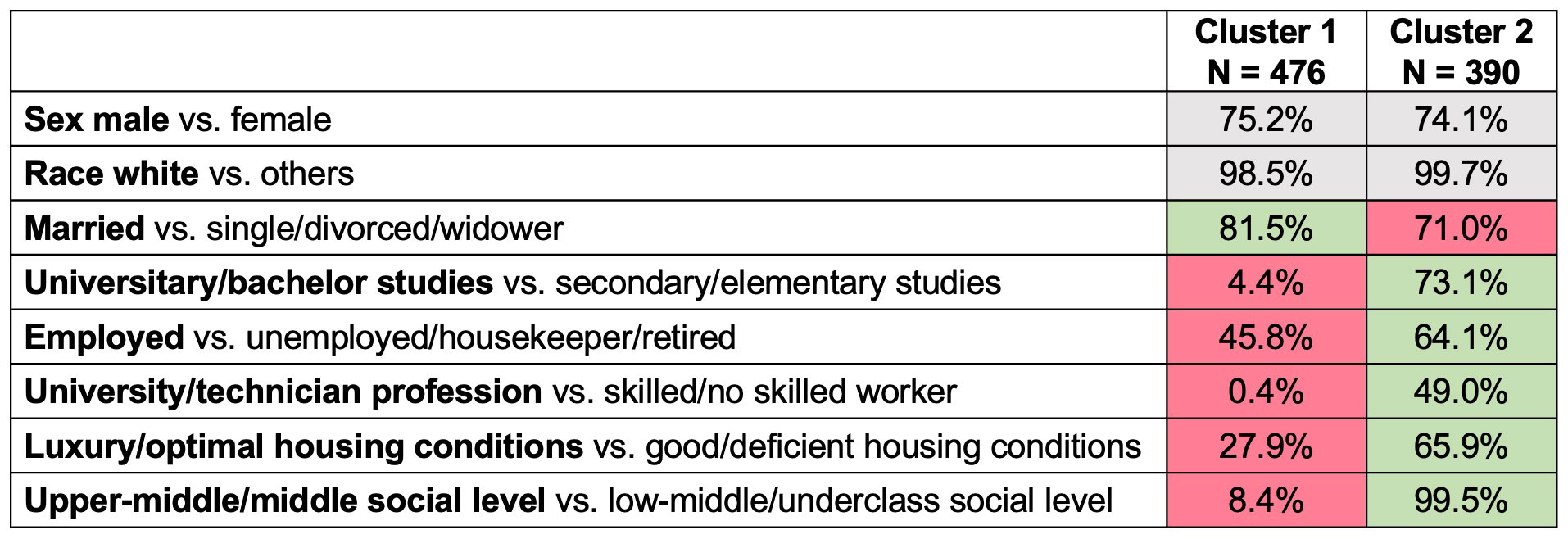Session Information
Date: Saturday, November 12, 2022
Title: Spondyloarthritis Including PsA – Diagnosis, Manifestations, and Outcomes Poster I
Session Type: Poster Session A
Session Time: 1:00PM-3:00PM
Background/Purpose: Previous studies have demonstrated that male gender and higher level of education are independently associated with a lower hazard of sick leave in patients with axial Spondyloarthritis (axSpA), while female gender has a disadvantageous effect on employment. However, few studies have identified socio-economic profiles of patients and their association with the severity of the disease and disability. The objectives of this study were: a) to identify clusters of patients according to their socio-economic characteristics; b) to evaluate the association of these clusters with the severity of the disease and permanent disability.
Methods: REGISPONSER (Spanish Registry of Spondyloarthritis) was a cross-sectional and multicentre study including Spanish patients with spondyloarthritis (SpA) according to the ESSG criteria. Patients considered by their treating rheumatologist as suffering from radiographic axSpA (r-axSpA) or ankylosing spondylitis (AS) were included in this specific analysis. A cluster analysis was conducted using information about sex, race, marital status, education, employment, profession, housing conditions and social level. Multiple correspondence analyses and k-means clustering methods were used. The clinical characteristics, burden of the disease and permanent disability were compared between the different clusters adjusting for disease duration.
Results: A total of 866 patients with r-axSpA were included in the analysis. Two clusters were found with regard to socio-economic characteristics (Table 1). Cluster 1 (n=476) showed a profile of patients predominantly married, with secondary/elementary studies, unemployed/housekeepers, no skilled workers, with good or deficient housing conditions and low-middle social level. On the other hand, cluster 2 (n=479) showed a profile of patients with predominantly university/bachelor studies, employed, with university/technician professions, optimal housing conditions and upper-middle social level.
In terms of clinical characteristics and burden of the disease, after adjusting for disease duration, patients from cluster 1 showed older age at the diagnosis (37.9 vs. 32.6), a longer diagnosis delay (7.8 vs. 6.8 years), higher body mass index (27.6 vs. 25.9) and greater structural damage in comparison with cluster 2 (BASRI total (5.7 vs. 4.6) and BASRI cervical (6.9 vs. 5.7)). No differences were found regarding smoking, peripheral and extra-musculoskeletal manifestations.
The access to biologic modified antirheumatic drugs (bDMARDs) was similar between the two groups (30.6% vs. 27.5%, p=0.376, for cluster 1 and 2, respectively). However, patients from cluster 1 showed a higher prevalence of permanent disability in comparison with cluster 2 after adjusting for disease duration [30.8% vs. 13.2%, OR 2.58 (95%CI 1.76 – 3.83), p< 0.001].
Conclusion: This study suggests that the socio-economic profile of patients with r-axSpA may have implications in the severity of the disease and in permanent disability despite a similar use of bDMARDs.
To cite this abstract in AMA style:
Lopez-Medina C, Ruiz-Vilchez D, Puche Larrubia M, Ladehesa-Pineda l, Font P, Collantes E. The Socioeconomic Profile of Patients with Radiographic Axial Spondyloarthritis Is Associated with the Severity of the Disease and with the Permanent Disability. a Cluster Analysis in a National Spanish Registry [abstract]. Arthritis Rheumatol. 2022; 74 (suppl 9). https://acrabstracts.org/abstract/the-socioeconomic-profile-of-patients-with-radiographic-axial-spondyloarthritis-is-associated-with-the-severity-of-the-disease-and-with-the-permanent-disability-a-cluster-analysis-in-a-national-spani/. Accessed .« Back to ACR Convergence 2022
ACR Meeting Abstracts - https://acrabstracts.org/abstract/the-socioeconomic-profile-of-patients-with-radiographic-axial-spondyloarthritis-is-associated-with-the-severity-of-the-disease-and-with-the-permanent-disability-a-cluster-analysis-in-a-national-spani/

